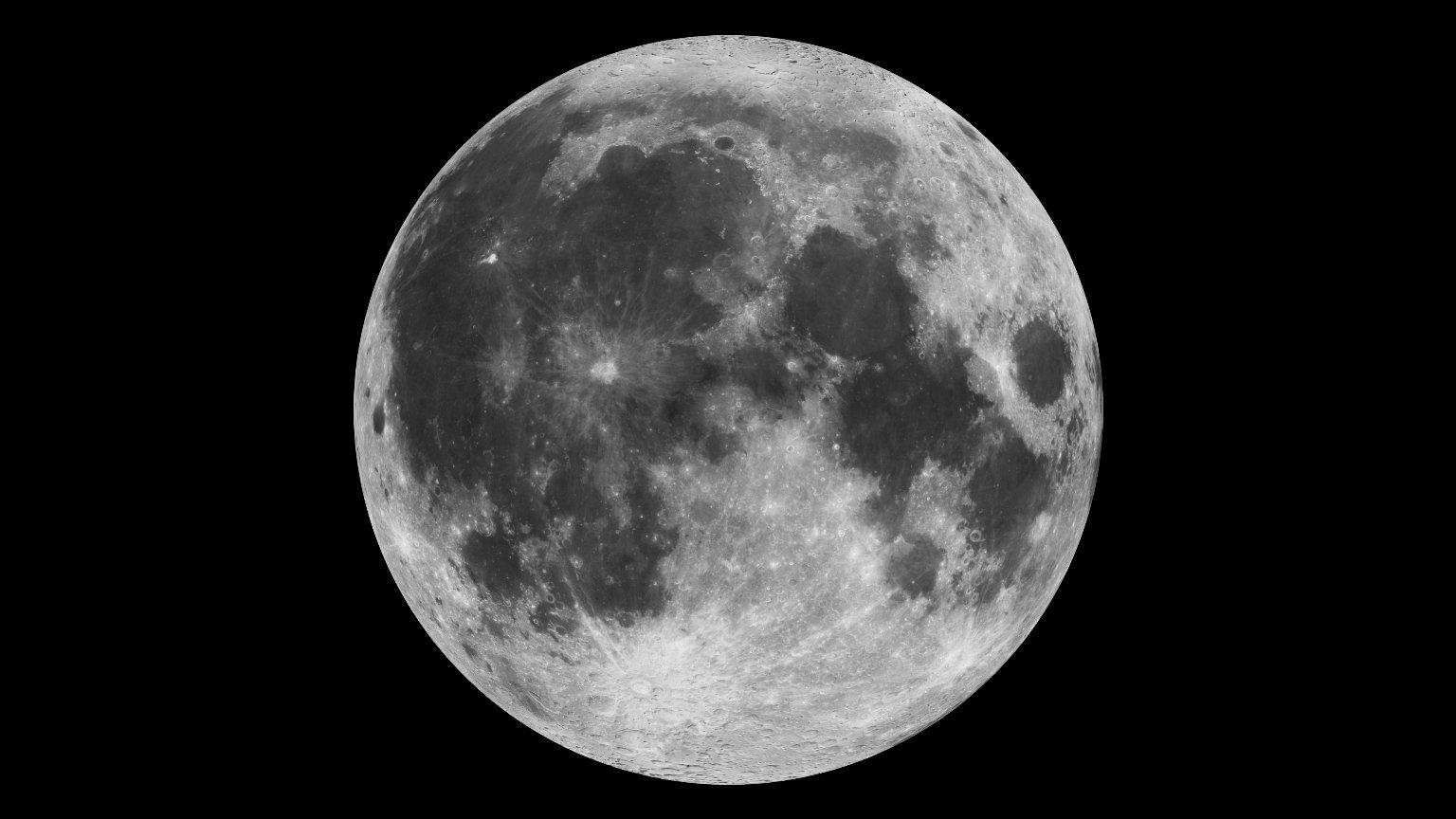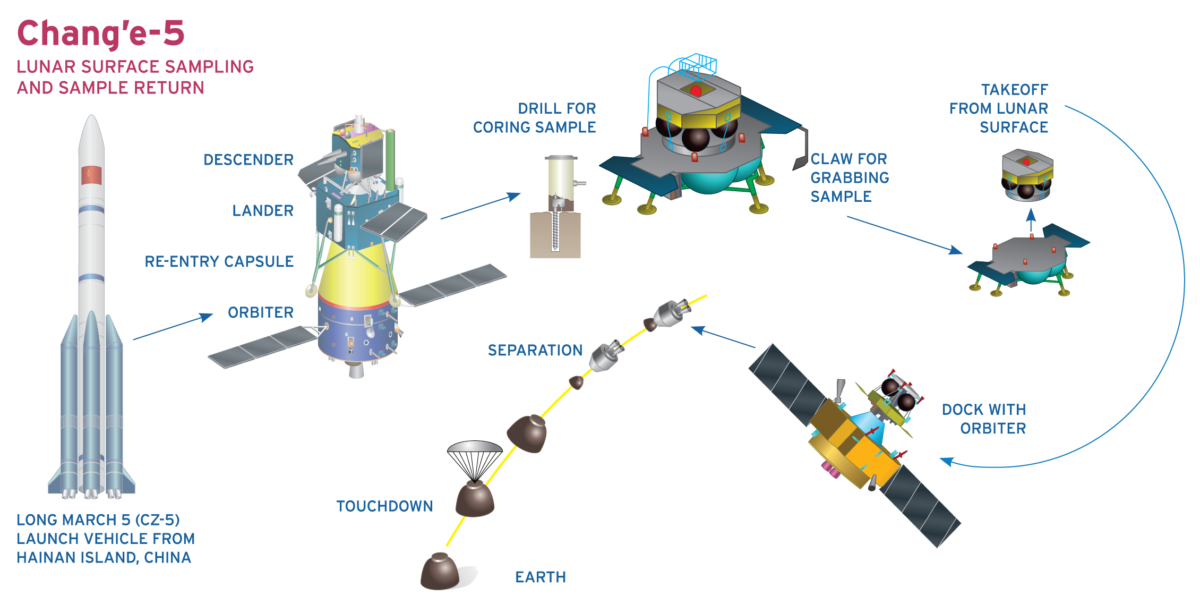
China wants a piece of the moon. Here's how it plans to handle lunar samples.
The nation plans to launch the Chang'e 5 sample-return mission to the moon later this year.

A glimpse into China's readiness to handle samples from the moon reveals steps to be taken for storage, processing and preparation of the specimens.
China's Chang'e 5 robotic moon mission is scheduled to launch later this year. That venture represents the third phase of China's Chang'e lunar exploration program: returning samples from the moon.
The reported candidate landing region for Chang'e 5 is the Rümker region, located in the northern Oceanus Procellarum ("Ocean of Storms"). The area is geologically complex and known for its volcanic activity.
The Chang'e 5 mission has four main parts: an orbiter, ascender, lander and Earth reentry module, which will contain up to 4.4 lbs. (2 kilograms) of lunar surface and subsurface samples.
Related: China on the moon! A history of Chinese lunar missions in pictures

Sample history
The former Soviet Union successfully executed three robotic lunar sample return missions. Luna 16 returned a small sample (101 grams) from Mare Fecunditatis ("Sea of Fertility") in September of 1970; in February 1972, Luna 20 returned 55 grams of soil from the Apollonius highlands region; and Luna 24 retrieved 170.1 grams of lunar samples from the moon's Mare Crisium ("Sea of Crisis") for return to Earth in August 1976.
The United States brought back much more moon material. The six Apollo missions that touched down on the lunar surface from 1969 to 1972 collected 842 lbs. (382 kg) of lunar samples at different landing sites on the lunar surface, including rocks, core samples, lunar soil and dust.
Get the Space.com Newsletter
Breaking space news, the latest updates on rocket launches, skywatching events and more!
China's moon rock plans
In a paper that was scheduled to be presented last month at the Lunar and Planetary Science Conference (LPSC), which ended up being cancelled due to concerns about the novel coronavirus, lead author G. L. Zhang from the National Astronomical Observatory, Chinese Academy of Sciences, details the main tasks of the Ground Research Application System (GRAS) of the country's lunar exploration project.
These tasks include: receiving lunar samples from the spacecraft system; establishing special facilities and laboratories for permanent local storage of samples and backup storage at another location; and preparation and preprocessing of lunar samples.
According to the requirements of the mission, GRAS formed a complete lunar sample preprocessing, storage and preparation plan.
This plan mainly includes: handover and transfer of lunar samples from the spacecraft system to GRAS, unsealing of the sample package, sample separation (drilled sample separation and scooped sample separation), sample storage (scooped and drilled samples) and sample preparation.
Related: Latest news about China's space program
A lunar pipeline
A detailed pipeline for this plan is discussed in the LPSC paper.
First, the returned lunar samples will be divided into scooped samples and drilled samples after entering the lab. Both scooped and drilled samples will then be divided into four categories: permanent storage samples, backup permanent storage samples, scientific research samples and exhibition samples.
"All the tools that contact with lunar sample are made of stainless steel, Teflon, quartz glass or materials of known composition to strictly control the factors that will affect subsequent scientific analysis. The water and oxygen content in the glove box, filled with pure [nitrogen], will be strictly monitored to prevent the lunar samples from Earth pollution," the LPSC paper notes.
U.S. and China approaches
"They seem to be taking a very similar approach to how we have (and continue to) process and curate Apollo samples (and other astromaterials in our collection)," said Ryan Zeigler, NASA's Apollo Sample Curator and manager of the Astromaterials Acquisition and Curation Office of the Astromaterials Research and Exploration Science Division at NASA's Johnson Space Center in Houston.
"There are a few minor differences, but that is to be expected since each mission has unique characteristics," Zeigler told Inside Outer Space.
The Chinese are clearly taking seriously the handling, storage and preliminary examination of a potential set of new lunar samples. The technology described is in many ways similar to the technology in the NASA Lunar Sample Laboratory, noted Carlton Allen, a former NASA Astromaterials Curator. (He is now retired.)
"The use of a nitrogen atmosphere for preparation, subdivision and storage has proven both necessary and sufficient over 50 years of lunar curation at NASA," Allen said.
Glovebox photos show that the nitrogen is maintained at positive pressure with respect to the laboratory atmosphere, which has proven important for contamination control. The importance of restricting the materials that come into contact with the samples, another important aspect of contamination control, is also recognized.
The technology described by G. L. Zhang and colleagues "has the potential to make these future lunar samples directly comparable to Apollo and Luna samples, which could significantly increase the value of each sample set," Allen said.
- The moon on Earth: Where are NASA's Apollo lunar rocks now?
- China's Chang'e program: missions to the moon
- The 20 most marvelous moon missions
Leonard David is the author of the book "Moon Rush: The New Space Race," published by National Geographic in May 2019. A longtime writer for Space.com, David has been reporting on the space industry for more than five decades. Follow us on Twitter @Spacedotcom or Facebook.
OFFER: Save 45% on 'All About Space' 'How it Works' and 'All About History'!
For a limited time, you can take out a digital subscription to any of our best-selling science magazines for just $2.38 per month, or 45% off the standard price for the first three months.
Join our Space Forums to keep talking space on the latest missions, night sky and more! And if you have a news tip, correction or comment, let us know at: community@space.com.

Leonard David is an award-winning space journalist who has been reporting on space activities for more than 50 years. Currently writing as Space.com's Space Insider Columnist among his other projects, Leonard has authored numerous books on space exploration, Mars missions and more, with his latest being "Moon Rush: The New Space Race" published in 2019 by National Geographic. He also wrote "Mars: Our Future on the Red Planet" released in 2016 by National Geographic. Leonard has served as a correspondent for SpaceNews, Scientific American and Aerospace America for the AIAA. He has received many awards, including the first Ordway Award for Sustained Excellence in Spaceflight History in 2015 at the AAS Wernher von Braun Memorial Symposium. You can find out Leonard's latest project at his website and on Twitter.
-
Lovethrust It’s interesting that the sampler will dock with the orbiter before returning to Earth, the Russians did a direct return from the lunar surface. The Chinese are bring back a much heftier sample than the Russians though and/or maybe this is a deliberate way to test the way for a much larger return mission (Mars?).Reply










